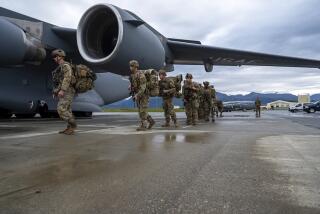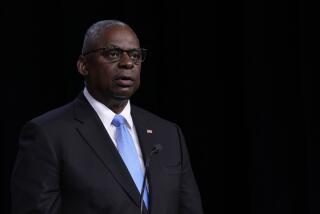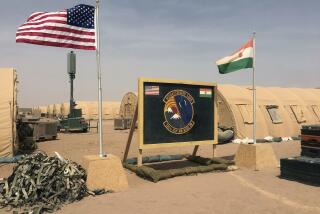Military in Florida has key role in war on terrorism
As home to dozens of highly specialized air-and-sea operations and the command post for tens of thousands of U.S. forces across the globe, Florida will play a crucial role in any military retaliation for the Sept. 11 attacks blamed on Osama bin Laden, military officials and analysts say.
Because of its strategically valuable location, including vast stretches of open territory ideal for military pilots, the Sunshine State -- and North Florida in particular -- has long been the staging ground for many Air Force operations. But with defense and intelligence forces gearing up, Florida’s command posts, air reconnaissance and naval operations are critical early players in the war on terrorism.
“The units that Florida has are absolutely at the center of the strategy and planning for what’s going to happen,” said an analyst at the Pentagon who asked not to be identified. “And operationally, the bases there are really, really involved.”
With a tight lid of secrecy on planning, Defense Department officials have sent more than 45,000 troops to the Middle East and put at least three aircraft carrier battle groups in place as military and diplomatic efforts continue.
As a result, at Florida’s two dozen military installations, including eight major bases, thousands of men and women in uniform are now absorbed in the massive deployment -- in some cases at the highest and most secretive levels of war planning.
From Pensacola, the so-called “cradle of naval aviation” where all Navy pilots are trained, to Tampa, where the shadowy world of Special Operations commandos is controlled, to the shipyards of Jacksonville and the air strips of Miami, Florida offers a foreboding military presence. But the major reason Florida is militarily important now is because the nerve center of the war is MacDill Air Force Base in Tampa, headquarters for Central Command, or Centcom in military jargon.
Yet part of the job of Florida-based military personnel is protecting America. The 25-ship USS John F. Kennedy Aircraft Carrier Battle Group, based at Mayport Naval Station near Jacksonville, is off the Atlantic Coast of the United States, providing air protection for New York, Washington and other major U.S. cities and commercial aircraft. Thousands of Floridians are involved in that mission alone, according to members of Congress aware of the Kennedy’s assignment, which the Pentagon will not confirm.
The Air Force’s command post for protecting U.S. skies is at Tyndall Air Force Base near Panama City in the Panhandle. Much of the Eastern Seaboard is protected by a unit of 18 F-15 Eagles with the 125th Fighter Wing from Jacksonville, which keeps at least six of those planes on “strip alert” -- ready to be in the air within five minutes -- at Homestead in Miami-Dade County.
“We’re on a peninsula, and we are a gateway into this country. Given the political climate, Florida is a critical state,” said John Myatt, a spokesman for the Florida Department of Military Affairs. “We have a very large role in homeland security.”
Three of the U.S. military’s nine commanders in chief, who answer only to the secretary of defense and the president, are based in Florida. Among them is the head of Southern Command in Miami, which oversees all military operations in Central and South America.
A huge collection of analysts and commanders is stationed at MacDill. There, under the highest levels of security, they monitor all political events and control all U.S. military action in a 25-nation swath that includes Pakistan, Afghanistan and the Persian Gulf states.
The Central Command is headed by Army Gen. Tommy R. Franks, who holds the same position and uses the same office that Army Gen. Norman Schwarzkopf did in the Persian Gulf War. Considered a long and forceful proponent of conventional weaponry, Franks is ensconced in an unconventional war of terrorism. He is an artillery and cavalry officer who has three Purple Hearts, having served in Germany during the Cold War, Korea, Vietnam and the Gulf War.
The headquarters staff numbers 900, but they oversee the work of 17,000 to 25,000 people. While ultimate responsibility for any military action lies with the White House and the Pentagon, Centcom is at the forefront of planning and strategy.
“We’re planning for any real and any range of contingencies,” said Col. Rick Thomas, a spokesman for the command. “We’re a unified command headquarters for Army, Navy and Air Force. So, yes, there are analysts. But there’s all sorts of people -- planners, intelligence, lawyers, chaplains, surgeons and cartographers.”
A Special Operations unit, which includes Navy SEALs and other units involved in clandestine operations, is also based at MacDill. But in living up to its stealthy Hollywood image, the command is veiled in secrecy and heavy security.
“I can only give you limited information, but we have 46,000 people around the world,” said a command spokeswoman who refused to give her name or provide a biography of her commander, Air Force Gen. Charles Holland. “Even the most mundane thing can be used against our forces. We just like to keep it quiet.”
Florida’s Panhandle is a rich territory for Air Force operations. The Jacksonville area is home to Mayport and a Naval Air Station; about one-fifth of all residents have ties to the Navy. North Florida, especially, offers a number of military hot spots.
>Besides hosting a fighter wing, Eglin Air Force Base is home to a command that develops specialized weapons. In the Gulf War, the group developed “bunker-buster” bombs that were used to cause deep underground damage in Iraq.
“They have the ability, on short turnaround, to develop special weapons for special targets,” said a military analyst who works for Congress. “Maybe they’ll have cave busters this time.”
Hurlburt Field near Eglin hosts the Air Force Special Operations command, which flies special equipment meant for the most challenging flying conditions, often the aircraft that drop Navy SEALS and Army Rangers into the field.
At Jacksonville Naval Air Station, a huge P-3 squadron is on maritime patrol, flying 10- to 14-hour shifts hunting for everything from submarines to wayward aircraft. There, too, is a naval aviation depot with 5,500 civilian employees who repair almost every type of Navy plane, including F-14 Tomcats, EA6B’s and F-18s.
With so much involvement from Florida, public officials and military experts agree that Florida could feel the impact of any U.S. military action -- including casualties -- more than most states.
“It’s more important than ever that we, as Floridians, support these people in the service, because almost everybody in Florida knows someone whose life is being affected,” said U.S. Rep. Jim Davis, D-Tampa. “This is a massive military operation that has Florida written all over it.”
More to Read
Sign up for Essential California
The most important California stories and recommendations in your inbox every morning.
You may occasionally receive promotional content from the Los Angeles Times.










